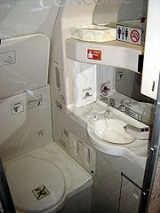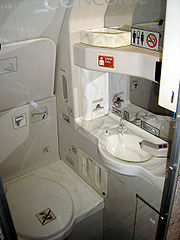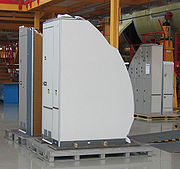
Aircraft lavatory
Encyclopedia

Minimum standards
Lavatories per passengerPassenger
A passenger is a term broadly used to describe any person who travels in a vehicle, but bears little or no responsibility for the tasks required for that vehicle to arrive at its destination....
provided aboard aircraft
Aircraft
An aircraft is a vehicle that is able to fly by gaining support from the air, or, in general, the atmosphere of a planet. An aircraft counters the force of gravity by using either static lift or by using the dynamic lift of an airfoil, or in a few cases the downward thrust from jet engines.Although...
vary considerably from airline
Airline
An airline provides air transport services for traveling passengers and freight. Airlines lease or own their aircraft with which to supply these services and may form partnerships or alliances with other airlines for mutual benefit...
to airline and aircraft
Aircraft
An aircraft is a vehicle that is able to fly by gaining support from the air, or, in general, the atmosphere of a planet. An aircraft counters the force of gravity by using either static lift or by using the dynamic lift of an airfoil, or in a few cases the downward thrust from jet engines.Although...
to aircraft. On board North American
North American
North American generally refers to an entity, people, group, or attribute of North America, especially of the United States and Canada together.-Culture:*North American English, a collective term used to describe American English and Canadian English...
aircraft, including low-cost, charter, and scheduled service airline
Airline
An airline provides air transport services for traveling passengers and freight. Airlines lease or own their aircraft with which to supply these services and may form partnerships or alliances with other airlines for mutual benefit...
carriers, the normally accepted minimum ratio of lavatories to passengers is approximately one lavatory for every 50 passengers. However, in premium cabin
First class travel
First class is the most luxurious class of accommodation on a train, passenger ship, airplane, or other conveyance. It is usually much more expensive than business class and economy class, and offers the best amenities.-Aviation:...
and business cabins
Business class
Business class is a travel class available on many commercial airlines and rail lines, known by brand names which vary by airline or rail company. In the airline industry, it was originally intended as an intermediate level of service between economy class and first class, but many airlines now...
, passengers may have access to multiple lavatories reserved primarily for their use. These ratios of lavatories to passengers vary considerably, depending upon which airline is being used with some first class
First class travel
First class is the most luxurious class of accommodation on a train, passenger ship, airplane, or other conveyance. It is usually much more expensive than business class and economy class, and offers the best amenities.-Aviation:...
passengers having one lavatory for every 12 passengers. Additionally, many of the larger long-haul airlines elect to equip their aircraft with larger lavatories for this particular group of passengers willing to pay higher fares.
Smaller commuter aircraft and regional aircraft designed for very short flight
Flight
Flight is the process by which an object moves either through an atmosphere or beyond it by generating lift or propulsive thrust, or aerostatically using buoyancy, or by simple ballistic movement....
s may not be equipped with lavatories. Recently, many regional airlines in North America have commenced the trend of eliminating the refilling of hand washing basin potable water tanks in order to reduce weight and reduce labor service costs, thus generating increased airline profits
Profit (accounting)
In accounting, profit can be considered to be the difference between the purchase price and the costs of bringing to market whatever it is that is accounted as an enterprise in terms of the component costs of delivered goods and/or services and any operating or other expenses.-Definition:There are...
derived through added fuel
Fuel
Fuel is any material that stores energy that can later be extracted to perform mechanical work in a controlled manner. Most fuels used by humans undergo combustion, a redox reaction in which a combustible substance releases energy after it ignites and reacts with the oxygen in the air...
savings due to reduction of aircraft weight and employee labor expenses. To facilitate sanitation, disinfectant hand-wipes are provided.
Fixtures
- Built in waterless toiletToiletA toilet is a sanitation fixture used primarily for the disposal of human excrement, often found in a small room referred to as a toilet/bathroom/lavatory...
s with push button flush - Call button - for assistance
- Electrical outlet
- Garbage can - small push door to discourage use of toilet to dispose of non-human waste items
- Handle bars to assist elderly or disabled passengers to get up from toilet
- Handwash faucet and sink (i.e., taps or push button)
- Paper towelsPaper towel dispenserA paper-towel dispenser is a device that dispenses paper towels in a public restroom when in use. It can either be operated by a handle or automatic....
- Soap dispenserSoap dispenserA soap dispenser is a device that, when manipulated or triggered appropriately, yields soap . It can be manually operated by means of a handle, or can be automatic...
- Toilet paperToilet paperToilet paper is a soft paper product used to maintain personal hygiene after human defecation or urination. However, it can also be used for other purposes such as blowing one's nose when one has a cold or absorbing common spills around the house, although paper towels are more used for the latter...
dispenser or linens - MirrorMirrorA mirror is an object that reflects light or sound in a way that preserves much of its original quality prior to its contact with the mirror. Some mirrors also filter out some wavelengths, while preserving other wavelengths in the reflection...
- Paper cupPaper cupA paper cup is a cup made out of paper and often lined with plastic or wax to prevent liquid from leaking out or soaking through the paper. It may be made of recycled paper and is widely used around the world.-History:...
dispenser - Sign on door to indicate lavatory in use or not in use
- Toiletries - handcream, facial tissue, sanitary napkins
Cabinets contain additional toilet paper and other toiletries, but they are locked.
The toilet and sink are often moulded plastic or a stainless steel sink. Floor is usually a non-slip surface.
In newer aircraft, the executive or first class lavatories are roomier and offer more toiletries and other comforts.
Types of aircraft lavatories

For this reason many modern lavatories are now no longer of the "chemical toilet
Chemical toilet
A chemical toilet is a toilet which uses chemicals to deodorize the waste instead of simply storing it in a hole, or piping it away to a sewage treatment plant. Common types include aircraft lavatory, some passenger train toilets and the portable toilets used on construction sites and at large...
blue water recirculated electric flush" variety. Instead lavatory manufacturers have progressed to "vacuum flush" technology to eliminate solid and liquid residue from the basin. Some of the advantages of "vacuum flush technology" systems, from aircraft designers’ perspective, is the increased safety attributes through less risk of corrosive
Corrosive
A corrosive substance is one that will destroy or irreversibly damage another surface or substance with which it comes into contact. The main hazards to people include damage to the eyes, the skin, and the tissue under the skin; inhalation or ingestion of a corrosive substance can damage the...
waste "spill over" into recesses around the lavatories which can be difficult to protect. Additionally, "vacuum flush systems" are considered to be less odor-inducing and substantially lighter which bear substantial fuel savings by way of reducing the need to carry excessive "blue recirculating water" as in the past.
Other characteristics of the modern aircraft lavatories' safety features include smoke detector
Smoke detector
A smoke detector is a device that detects smoke, typically as an indicator of fire. Commercial, industrial, and mass residential devices issue a signal to a fire alarm system, while household detectors, known as smoke alarms, generally issue a local audible and/or visual alarm from the detector...
s, waste receptacle, portable fire containment halon extinguishing bottles and "oxygen-smothering" "flapper lids" fitted to the hand towel waste disposal receptacles. Over time these protective devices have been incorporated into aircraft lavatory designs due to fires that have started when the careless cigarette
Cigarette
A cigarette is a small roll of finely cut tobacco leaves wrapped in a cylinder of thin paper for smoking. The cigarette is ignited at one end and allowed to smoulder; its smoke is inhaled from the other end, which is held in or to the mouth and in some cases a cigarette holder may be used as well...
smoker of the past or the clandestine cigarette smoker of the present has incorrectly disposed of their smoking material.

